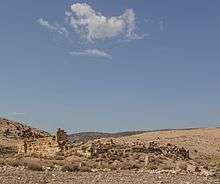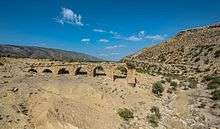Aggar (city)
Aggar was a town in the Roman province of Byzacena. One of two cities in the area, it left vast ruins that are now called Henchir Sidi Amara. These edifices are situated in the plain of Kairouan,[1][2] around 60 kilometres east of Maktar.[3]
A distinct Sidi Amara further north in Tunisia holds the ruins of the ancient town of Avioccala, located in the Roman province of Africa Proconsularis.
Ruins

The ruins of Aggar, whose identity is confirmed by inscriptions found there, include those of a triumphal arch opening onto a large porticoed area, with a temple behind it, which must have been the forum and the capitol. A Byzantine fortress, 30 m square with square, slightly projecting corner towers was built on an arcaded structure identified as a temple of Juno. Another temple of unidentified dedication adjoins this citadel. Outside the city proper stands a two-storey mausoleum of a certain C. Marius Romanus with roofing almost intact. A ruined theatre can also be seen. About 1500 metres west of the town, the wadi Jilf was crossed by a bridge originally of ten arches, of which six remain.[1][4]
History

The town, which stood at the outlet of a rocky pass, was 16 miles from Thapsus.[5] It is mentioned in the De Bello Africo attributed to Aulus Hirtius, chapters 67 and 79.[6] Aggar appears in the Tabula Peutingeriana[7]
In AD 232, Aggar was granted the rank of municipium (CIL VIII 1, 714),[2] and later became a colonia.[4]
Bishopric
The only ancient bishop of Aggar whose name is known to us is Donatus, one of the Catholic bishops whom the Arian Vandal king Huneric summoned to Carthage in 484 and then exiled.[5]
No longer a residential bishopric, Aggar is today listed by the Catholic Church as a titular see.[8]
References
- 1 2 M. H. Fantar, "Aggar" in Encyclopédie Berbère
- 1 2 "Aggar." Hubert Cancik, Helmuth Schneider (editors), Brill’s New Pauly. Antiquity volumes (Brill Online, 2014) Retrieved 07 October 2014
- ↑ The Stages of Silence
- 1 2 A. Ennabli, Aggar (Henchir Sidi Amara) Tunisia" in The Princeton Encyclopedia of Classical Sites
- 1 2 Stefano Antonio Morcelli, Africa christiana, Volume I, Brescia 1816, pp. 71–72
- ↑ C. Iulii Caesaris Commentarii de bello Gallico et civili: accedunt libri De bello Alexandrino, Africano et Hispaniensi, Volume 2 (Ex Typis viduae Pomba et filiorum, 1818). pp. 135, 145
- ↑ Image of section of Tabula Peutingeriana
- ↑ Annuario Pontificio 2013 (Libreria Editrice Vaticana 2013 ISBN 978-88-209-9070-1), p. 827
Coordinates: 35°41′18″N 9°10′0″E / 35.68833°N 9.16667°E